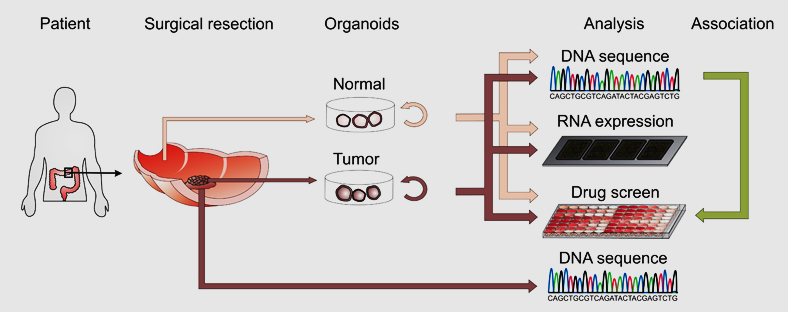Colorectal cancer (CRC) is one of the most common types of cancer worldwide, second only to lung and breast cancer, and affects both men and women. CRC is heterogeneous, manifesting with variegated cell morphology, histopathology and chemo-resistant capacity. These biological characteristics of CRC have led to the failure of conventional therapeutics. In order to improve the prognosis of patients with CRC, preclinical tumor models are essential for simulating primary tumors, developing novel treatments and predicting drug responses in vivo.
Intestinal stem cells grown in Matrigel (an extracellular matrix component that mimics the extracellular environment) can differentiate into epithelial organoids containing all cell types of the colon. These have become attractive models for the study of colorectal cancer because they are very similar to the patient's organ biology, can be used for functional studies, and more importantly, the response to pharmacological treatments mimics the in vivo response of individual patient.
Organoid culture has had an impact on CRC research. With the widespread use of this technique, it is expected that it could provide the missing link between cell culture and in vivo models of the disease. By providing an easy-to-handle model in which genotype and phenotype can be directly compared in a short space of time, the use of organoid culture opens up an array of different experimental techniques that were impossible before.
 Figure 1. Overview of the procedure.
Figure 1. Overview of the procedure.
Colorectal cancer-derived organoids are polarized epithelial microtissues derived from resected CRC patient material and cultured in a 3D matrix in the presence of stem cell stimulating factors to sustain in vitro growth. At OrganoLab, we use organoid technology to culture and screen tissues from patient-derived colon tumor and normal cells in a physiologically relevant microenvironment. We have generated a biobank of colon tumor organoids and normal colon organoids derived from patients with colorectal cancer undergoing surgical resection. The histopathological characteristics were evaluated and matched with the original tumor. Next Generation Sequencing (NGS) and Copy Number analysis (CNA) were performed to compare the genetic landscape of both the colon tumor organoids and frozen colorectal cancer tissue. With our CRC organoids, OrganoLabcan provide excellent insights for the basic research of CRC and the development of novel therapeutics. If you have any questions or specific needs, please feel free to contact us.
Key Advantages:
- Functionally identify inhibitors of CRC tumor outgrowth and development
- High-content imaging for the sensitive detection of therapeutic responses
- Sensitive and robust measurement of clinically-relevant endpoints
- Test the mode of action, activity, toxicity and synergy in the same 3D assay
References
- Engel R. M. et al.; Patient-Derived Colorectal Cancer Organoids Upregulate Revival Stem Cell Marker Genes following Chemotherapeutic Treatment. J Clin Med. 2020, 9(1): 128.
- Zhao H, et al.; Sphere‑forming assay vs. organoid culture: Determining long‑term stemness and the chemoresistant capacity of primary colorectal cancer cells. Int J Oncol. 2019, 54(3): 893-904.
- Young M, et al.; Organoids as a Model for Colorectal Cancer. Curr Colorectal Cancer Rep. 2016, 12(5): 281-287.
- van de Wetering M. et al.; Prospective derivation of a living organoid biobank of colorectal cancer patients. Cell, 2015, 161(4): 933-945.
Online Inquiry